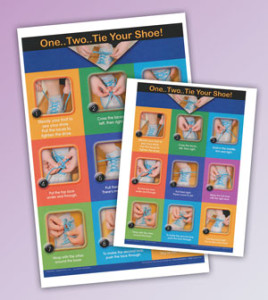 Teaching shoe tying is often not prioritized these days due to the advent of velcro and slip on shoes. Due to the frustrations experienced by their children, many parents tend to choose the easy way out buying shoes that do not require tying. Fast forward a year or two, parents find themselves frantically tying their second grader’s shoes on the sidelines of a soccer game or just before the bus. These parents are silently berating themselves for having given in earlier and are hoping for a miracle. First and second grade teachers are similarly frustrated when children arrive in their classroom lacking a skill that should have been learned in kindergarten. Deb Vozel, an intervention specialist at Cline Elementary School in Centerville, OH decided she needed to do something about it. Together with Bhanu Raghavan, OTR/L she started a shoe tying club to coach any second grader lacking shoe tying skills. The club turned out to be a resounding success!
Teaching shoe tying is often not prioritized these days due to the advent of velcro and slip on shoes. Due to the frustrations experienced by their children, many parents tend to choose the easy way out buying shoes that do not require tying. Fast forward a year or two, parents find themselves frantically tying their second grader’s shoes on the sidelines of a soccer game or just before the bus. These parents are silently berating themselves for having given in earlier and are hoping for a miracle. First and second grade teachers are similarly frustrated when children arrive in their classroom lacking a skill that should have been learned in kindergarten. Deb Vozel, an intervention specialist at Cline Elementary School in Centerville, OH decided she needed to do something about it. Together with Bhanu Raghavan, OTR/L she started a shoe tying club to coach any second grader lacking shoe tying skills. The club turned out to be a resounding success!
Shoe tying club met during the second quarter of school. The club members were chosen by their classroom teachers, and included both typical and children with special needs. The steps used for shoe-tying came from the poster One-Two Tie Your Shoe. This poster was adapted from the book Self-Care with Flair! The club members were placed in groups of four to five. They met daily before the end of their morning session. Mrs. Vozel and her aide led the club daily with weekly consultation from the OT. Club members practiced a few steps each week. Once a step was mastered they were introduced to the subsequent step. If a child had a particular difficulty with mastering a step the OT helped to break the steps down even further (activity analysis). At the end of the second quarter all the club members were successfully tying their shoes. Mrs. Vozel celebrated their success by giving each member a certificate and a copy of the poster One-Two Tie Your Shoe.
The nine easy steps in One-Two Tie Your Shoe are a convenient and quick way to teach this skill to any child. The laminated poster can be displayed in the classroom, on the refrigerator at home, in day-care centers and wherever young children are learning to tie their shoes.
